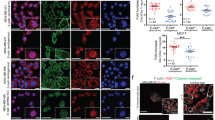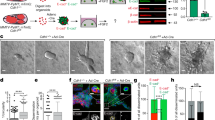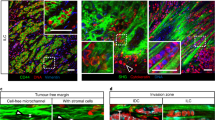Abstract
Cell–cell adhesion is an elementary process in normal epithelial cellular architecture. Several studies have shown the role mediated by cadherins in this process, besides their role in the maintenance of cell polarity, differentiation and cell growth. However, during tumour progression, these molecules are frequently altered. In breast cancer, tumours that overexpress P-cadherin usually present a high histological grade, show decreased cell polarity and are associated with worse patient survival. However, little is known about how this protein dictates the very aggressive behaviour of these tumours. To achieve this goal, we set up two breast cancer cell models, where P-cadherin expression was differently modulated and analysed in terms of cell invasion, motility and migration. We show that P-cadherin overexpression, in breast cancer cells with wild-type E-cadherin, promotes cell invasion, motility and migration. Moreover, we found that the overexpression of P-cadherin induces the secretion of matrix metalloproteases, specifically MMP-1 and MMP-2, which then lead to P-cadherin ectodomain cleavage. Further, we showed that soluble P-cadherin fragment is able to induce in vitro invasion of breast cancer cells. Overall, our results contribute to elucidate the mechanism underlying the invasive behaviour of P-cadherin expressing breast tumours.
This is a preview of subscription content, access via your institution
Access options
Subscribe to this journal
Receive 50 print issues and online access
$259.00 per year
only $5.18 per issue
Buy this article
- Purchase on Springer Link
- Instant access to full article PDF
Prices may be subject to local taxes which are calculated during checkout







Similar content being viewed by others
References
Blick T, Widodo E, Hugo H, Waltham M, Lenburg ME, Neve RM et al. (2008). Epithelial mesenchymal transition traits in human breast cancer cell lines. Clin Exp Metastasis 25: 629–642.
Cavallaro U, Christofori G . (2004). Cell adhesion and signalling by cadherins and Ig-CAMs in cancer. Nat Rev Cancer 4: 118–132.
Charafe-Jauffret E, Ginestier C, Monville F, Finetti P, Adelaide J, Cervera N et al. (2006). Gene expression profiling of breast cell lines identifies potential new basal markers. Oncogene 25: 2273–2284.
Chen H, Paradies NE, Fedor-Chaiken M, Brackenbury R . (1997). E-cadherin mediates adhesion and suppresses cell motility via distinct mechanisms. J Cell Sci 110: 345–356.
Chhabra ES, Higgs HN . (2007). The many faces of actin: matching assembly factors with cellular structures. Nat Cell Biol 9: 1110–1121.
De Paul AL, Bonaterra M, Soler AP, Knudsen KA, Roth FD, Aoki A . (2005). Soluble p-cadherin found in human semen. J Androl 26: 44–47.
Fenteany G, Janmey PA, Stossel TP . (2000). Signaling pathways and cell mechanics involved in wound closure by epithelial cell sheets. Curr Biol 10: 831–838.
Frixen UH, Behrens J, Sachs M, Eberle G, Voss B, Warda A et al. (1991). E-cadherin-mediated cell-cell adhesion prevents invasiveness of human carcinoma cells. J Cell Biol 113: 173–185.
Fujimoto D, Hirono Y, Goi T, Katayama K, Yamaguchi A . (2008). Prognostic value of protease-activated receptor-1 (PAR-1) and matrix metalloproteinase-1 (MMP-1) in gastric cancer. Anticancer Res 28: 847–854.
Gamallo C, Moreno-Bueno G, Sarrio D, Calero F, Hardisson D, Palacios J . (2001). The prognostic significance of P-cadherin in infiltrating ductal breast carcinoma. Mod Pathol 14: 650–654.
Herren B, Levkau B, Raines EW, Ross R . (1998). Cleavage of beta-catenin and plakoglobin and shedding of VE-cadherin during endothelial apoptosis: evidence for a role for caspases and metalloproteinases. Mol Biol Cell 9: 1589–1601.
Ito T, Ito M, Shiozawa J, Naito S, Kanematsu T, Sekine I . (1999). Expression of the MMP-1 in human pancreatic carcinoma: relationship with prognostic factor. Mod Pathol 12: 669–674.
Kang Y, Siegel PM, Shu W, Drobnjak M, Kakonen SM, Cordon-Cardo C et al. (2003). A multigenic program mediating breast cancer metastasis to bone. Cancer Cell 3: 537–549.
Lauffenburger DA, Horwitz AF . (1996). Cell migration: a physically integrated molecular process. Cell 84: 359–369.
Lochter A, Galosy S, Muschler J, Freedman N, Werb Z, Bissell MJ . (1997). Matrix metalloproteinase stromelysin-1 triggers a cascade of molecular alterations that leads to stable epithelial-to-mesenchymal conversion and a premalignant phenotype in mammary epithelial cells. J Cell Biol 139: 1861–1872.
Lombaerts M, van Wezel T, Philippo K, Dierssen JW, Zimmerman RM, Oosting J et al. (2006). E-cadherin transcriptional downregulation by promoter methylation but not mutation is related to epithelial-to-mesenchymal transition in breast cancer cell lines. Br J Cancer 94: 661–671.
Longatto Filho A, Albergaria A, Paredes J, Moreira MA, Milanezi F, Schmitt FC . (2005). P-cadherin expression in glandular lesions of the uterine cervix detected by liquid-based cytology. Cytopathology 16: 88–93.
Mannello F, Tonti GA, Medda V, Pederzoli A, Sauter ER . (2008). Increased shedding of soluble fragments of P-cadherin in nipple aspirate fluids from women with breast cancer. Cancer Sci 99: 2160–2169.
Murray GI, Duncan ME, Arbuckle E, Melvin WT, Fothergill JE . (1998a). Matrix metalloproteinases and their inhibitors in gastric cancer. Gut 43: 791–797.
Murray GI, Duncan ME, O’Neil P, McKay JA, Melvin WT, Fothergill JE . (1998b). Matrix metalloproteinase-1 is associated with poor prognosis in oesophageal cancer. J Pathol 185: 256–261.
Neve RM, Chin K, Fridlyand J, Yeh J, Baehner FL, Fevr T et al. (2006). A collection of breast cancer cell lines for the study of functionally distinct cancer subtypes. Cancer Cell 10: 515–527.
Noe V, Fingleton B, Jacobs K, Crawford HC, Vermeulen S, Steelant W et al. (2001). Release of an invasion promoter E-cadherin fragment by matrilysin and stromelysin-1. J Cell Sci 114: 111–118.
Okuyama N, Matsumine A, Kosugi R, Wakabayashi H, Uchida A . (2008). Matrix metalloproteinase-1 is a crucial bone metastasis factor in a human breast cancer-derived highly invasive cell line. Oncol Rep 20: 1497–1504.
Oliveira MJ, Van Damme J, Lauwaet T, De Corte V, De Bruyne G, Verschraegen G et al. (2003). Beta-casein-derived peptides, produced by bacteria, stimulate cancer cell invasion and motility. EMBO J 22: 6161–6173.
Paredes J, Albergaria A, Oliveira JT, Jeronimo C, Milanezi F, Schmitt FC . (2005). P-cadherin overexpression is an indicator of clinical outcome in invasive breast carcinomas and is associated with CDH3 promoter hypomethylation. Clin Cancer Res 11: 5869–5877.
Paredes J, Correia AL, Ribeiro AS, Albergaria A, Milanezi F, Schmitt FC . (2007). P-cadherin expression in breast cancer: a review. Breast Cancer Res 9: 214.
Paredes J, Correia AL, Ribeiro AS, Schmitt F . (2007). Expression of p120-catenin isoforms correlates with genomic and transcriptional phenotype of breast cancer cell lines. Cell Oncol 29: 467–476.
Paredes J, Correia AL, Ribeiro AS, Milanezi F, Camesselle-Teijeiro J, Schmitt F . (2008). Breast carcinomas that co-express E- and P-cadherin are associated with p120-catenin cytoplasmic localization and poor patient survival. J Clin Pathol 61: 856–862.
Paredes J, Milanezi F, Reis-Filho JS, Leitao D, Athanazio D, Schmitt F . (2002). Aberrant P-cadherin expression: is it associated with estrogen-independent growth in breast cancer? Pathol Res Pract 198: 795–801.
Paredes J, Stove C, Stove V, Milanezi F, Van Marck V, Derycke L et al. (2004). P-cadherin is up-regulated by the antiestrogen ICI 182 780 and promotes invasion of human breast cancer cells. Cancer Res 64: 8309–8317.
Peralta Soler A, Knudsen KA, Salazar H, Han AC, Keshgegian AA . (1999). P-cadherin expression in breast carcinoma indicates poor survival. Cancer 86: 1263–1272.
Remacle AG, Noel A, Duggan C, McDermott E, O′Higgins N, Foidart JM et al. (1998). Assay of matrix metalloproteinases types 1, 2, 3 and 9 in breast cancer. Br J Cancer 77: 926–931.
Sarrio D, Rodriguez-Pinilla SM, Hardisson D, Cano A, Moreno-Bueno G, Palacios J . (2008). Epithelial-mesenchymal transition in breast cancer relates to the basal-like phenotype. Cancer Res 68: 989–997.
Simpson KJ, Selfors LM, Bui J, Reynolds A, Leake D, Khvorova A et al. (2008). Identification of genes that regulate epithelial cell migration using an siRNA screening approach. Nat Cell Biol 10: 1027–1038.
Soler AP, Russo J, Russo IH, Knudsen KA . (2002). Soluble fragment of P-cadherin adhesion protein found in human milk. J Cell Biochem 85: 180–184.
Stefansson IM, Salvesen HB, Akslen LA . (2004). Prognostic impact of alterations in P-cadherin expression and related cell adhesion markers in endometrial cancer. J Clin Oncol 22: 1242–1252.
Stetler-Stevenson WG, Aznavoorian S, Liotta LA . (1993). Tumor cell interactions with the extracellular matrix during invasion and metastasis. Annu Rev Cell Biol 9: 541–573.
Taniuchi K, Nakagawa H, Hosokawa M, Nakamura T, Eguchi H, Ohigashi H et al. (2005). Overexpressed P-cadherin/CDH3 promotes motility of pancreatic cancer cells by interacting with p120ctn and activating rho-family GTPases. Cancer Res 65: 3092–3099.
Thiery JP . (2002). Epithelial-mesenchymal transitions in tumour progression. Nat Rev Cancer 2: 442–454.
Van Marck V, Stove C, Van Den Bossche K, Stove V, Paredes J, Vander Haeghen Y et al. (2005). P-cadherin promotes cell-cell adhesion and counteracts invasion in human melanoma. Cancer Res 65: 8774–8783.
Vu TH, Werb Z . (2000). Matrix metalloproteinases: effectors of development and normal physiology. Genes Dev 14: 2123–2133.
Yamazaki D, Kurisu S, Takenawa T . (2005). Regulation of cancer cell motility through actin reorganization. Cancer Sci 96: 379–386.
Acknowledgements
The work presented was mainly supported by a scientific project (POCI/BIA-BCM/59252/2004) financed by the Portuguese Science and Technology Foundation (FCT). FCT also provided research grants as follows: Programa Ciência 2007 (FCT) for Joana Paredes, and PhD research grants for Ana Sofia Ribeiro (SFRH/BD/36096/2007) and André Albergaria (SFRH/BD/15316/2005).
Author information
Authors and Affiliations
Corresponding author
Additional information
Supplementary Information accompanies the paper on the Oncogene website (http://www.nature.com/onc)
Rights and permissions
About this article
Cite this article
Ribeiro, A., Albergaria, A., Sousa, B. et al. Extracellular cleavage and shedding of P-cadherin: a mechanism underlying the invasive behaviour of breast cancer cells. Oncogene 29, 392–402 (2010). https://doi.org/10.1038/onc.2009.338
Received:
Revised:
Accepted:
Published:
Issue Date:
DOI: https://doi.org/10.1038/onc.2009.338
Keywords
This article is cited by
-
Cytosolic Cadherin 4 promotes angiogenesis and metastasis in papillary thyroid cancer by suppressing the ubiquitination/degradation of β-catenin
Journal of Translational Medicine (2024)
-
Polo-like kinase 4 (Plk4) potentiates anoikis-resistance of p53KO mammary epithelial cells by inducing a hybrid EMT phenotype
Cell Death & Disease (2023)
-
Regulatory function of DNA methylation mediated lncRNAs in gastric cancer
Cancer Cell International (2022)
-
Identification of TUBB2A by quantitative proteomic analysis as a novel biomarker for the prediction of distant metastatic breast cancer
Clinical Proteomics (2020)
-
Increased expression of P-cadherin is an indicator of poor prognosis in breast cancer: a systematic review and meta-analysis
Breast Cancer Research and Treatment (2020)



